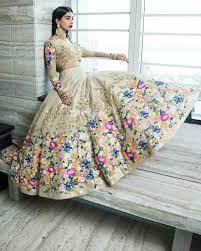The charm of Bandhani, an age-old tie-dye art form, has transcended generations and remains an integral part of India’s rich textile heritage. Today, Bandhani lehengas beautifully blend tradition and trend, making them a popular choice among brides and fashion enthusiasts. In this blog, we’ll explore the enchanting world of Bandhani lehengas, where the timeless allure of tradition meets the dynamism of contemporary fashion.
- A Glimpse into Bandhani:Bandhani, also known as Bandhej, is an ancient Indian textile artistry that involves tie-dyeing fabric to create intricate patterns. This labor-intensive craft originated in the western states of Rajasthan and Gujarat and has been celebrated for its vibrant colors and mesmerizing designs for centuries.
- Lehengas: A Bridal Favorite:Lehengas, with their elegance and grace, have long been the choice of attire for Indian brides. Combining Bandhani with lehengas has resulted in a perfect fusion of tradition and modern bridal fashion. Bandhani lehengas have gained immense popularity among brides for their timeless appeal.
- Traditional Color Palette:Bandhani lehengas often feature a traditional color palette, with rich hues like red, maroon, royal blue, and green. These colors not only symbolize festivity and auspiciousness but also showcase the authenticity of Bandhani craft.
- Intricate Bandhani Patterns: The heart of any Bandhani lehenga lies in its intricate patterns. Various Bandhani techniques, such as Leheriya, Shikari, and Mothda, are used to create mesmerizing designs on the fabric. Brides can choose from a wide range of motifs, from floral and peacock patterns to geometric and abstract designs.
- Contemporary Twist: Modern brides are not just adhering to tradition; they are also experimenting with contemporary elements. Bandhani lehengas often incorporate innovative blouse designs, embellishments, and draping styles to add a touch of modernity to the ensemble.
- Fusion of Fabrics: Traditional Bandhani is done on fabrics like silk and cotton. However, contemporary Bandhani lehengas experiment with various fabrics, including chiffon, georgette, and crepe, to offer comfort and movement to the bride. This fusion of fabrics adds versatility to the Bandhani lehenga.
- Accessorizing with Grace: To complete the look, brides often opt for traditional jewelry pieces like Kundan sets, jhumkas, and chokers. However, minimalistic and contemporary jewelry can also complement Bandhani lehengas, striking a harmonious balance between old and new.
- Draping Styles: Brides have the freedom to choose from a variety of draping styles. While the traditional way is to drape the dupatta over the head, many brides now prefer to drape it in a way that showcases the intricate patterns and adds a contemporary flair to the ensemble.
- Regional Influences: Different regions in India have their own unique Bandhani styles. Brides often choose Bandhani lehengas that reflect their regional heritage, adding a personal touch to their bridal attire.
- Conclusion: A Bridal Masterpiece:Bandhani lehengas effortlessly merge tradition and trend, creating bridal ensembles that are both timeless and fashionable. They serve as a testament to the enduring appeal of India’s textile heritage and the creativity of modern brides. Whether you’re a bride looking to honor your roots or a fashion enthusiast celebrating the beauty of Bandhani, these exquisite lehengas continue to capture hearts and make a statement in the world of bridal fashion.

